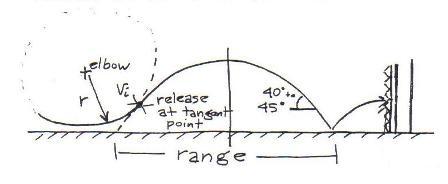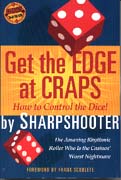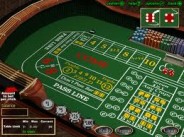
Get the Edge at Craps
The Two Keys to Successful Precision Dice Control
 Chris Pawlicki (AKA Sharpshooter) has an engineering background which he has put to good use in his dice control research. He and Jerry Patterson created the "dice control revolution" with the development of the first dice control course in 1996. He published his own book, How to Control the Dice in 2002, and launched Sharpshootercraps.com in 2003. Chris's website is www.sharpshootercraps.com Craps from the Zone.
Chris Pawlicki (AKA Sharpshooter) has an engineering background which he has put to good use in his dice control research. He and Jerry Patterson created the "dice control revolution" with the development of the first dice control course in 1996. He published his own book, How to Control the Dice in 2002, and launched Sharpshootercraps.com in 2003. Chris's website is www.sharpshootercraps.com Craps from the Zone. Note from Sharpshooter: I first wrote about the physical phenomena of dice trajectories and other critical elements of dice control in my ground-breaking 95,000 word book, Get the Edge at Craps, How to Control the Dice, Bonus Books, Chicago. I discuss the optimal 45-degree launch angle, the synchronized dice movements and the shortening of the horizontal distance, or range that the dice must travel.
After you have set and carefully gripped the cubes, you will gently launch them into their trajectory; parallel to the sides of the table and perpendicular to the far, or back wall.
To secure an edge over the house, your objective is to launch the dice at the optimal angle to accomplish a "soft landing" and minimize the random motion of the dice after they collide with the back wall pyramids and come to rest.
The First Key is the 45-Degree Launch Angle.
I have stated in my book and several years before that in the Sharpshooter/PARR Dice Control Course that the optimal launch angle for projectile motion is 45 degrees. Artillerymen have known for hundreds of years that the maximum range could be reached for a given amount of gunpowder if the cannon ball was fired at about 40 degrees to the horizon. Because air resistance and wind are factors when firing a massive cannon ball hundreds of feet through the air, a slightly more horizontal component of motion is needed.
Applying this principle to dice control and standing as close as possible to the stickman to cut down the total distance of the toss, will greatly reduce the energy needed to propel the dice to their target (and subsequently has to be burned off as the dice finally come to rest). By applying differential calculus to projectile equations of position and motion, I was able to prove, mathematically that 45 degrees is optimal if wind and air resistance are neglected. For a pair of acrylic or acetate dice thrown a few feet above a table in a controlled atmosphere, a launch angle approaching 45 degrees is best. I also developed new formulas for calculating other interesting information about one’s throw.
The dice should leave your hand near the required 45-degree angle, rotating side-by-side in a synchronized fashion. As the dice swing about the throwing elbow, the dice actually travel in a circular arc because your forearm should act like a fixed radius. At the moment the dice are released, the circular arc is tangent to the parabolic trajectory. You will want to release the dice at, or near a 45 degree angle in order to maximize the range of the throw for a given initial velocity. Refer to Figure 1 below.

Figure 1
Question: How can you be sure that you have launched at 45 degrees or as close as possible thereto?
The quick answer is in the table below, which shows how high to throw the dice above the table bed to achieve the optimal 45-degree launch. Maximum parabolic heights (apexes) for various horizontal ranges for the 45-degree launch angle are calculated. I have also included some other values that I will explain in a moment. It does not matter which table position you throw from, the distance and launch angle will determine the height.
|
Flight Parameter Table for the 45-Degree Launch Angle |
||||
|
Horizontal Range (feet)
|
Apex Height, Ymax (feet)
|
Release Velocity (feet per second)
|
Time of Flight (seconds)
|
Kinetic Energy
(in-lbs)
|
|
4
|
1.00
|
11.34
|
0.50
|
1.03
|
|
5
|
1.25
|
12.68
|
0.56
|
1.29
|
|
6
|
1.50
|
13.90
|
0.61
|
1.55
|
|
7
|
1.75
|
15.01
|
0.66
|
1.81
|
|
8
|
2.00
|
16.05
|
0.70
|
2.07
|
|
9
|
2.25
|
17.02
|
0.75
|
2.32
|
|
10
|
2.50
|
17.94
|
0.79
|
2.58
|
|
11
|
2.75
|
18.81
|
0.83
|
2.84
|
|
12
|
3.00
|
19.66
|
0.86
|
3.10
|
|
14
|
3.50
|
21.23
|
0.93
|
3.61
|
|
16
|
4.00
|
22.70
|
1.00
|
4.13
|
As you practice at home, you will get a feel for the apex heights above the table surface needed to attain the 45-degree launch angle. This should be part of your normal practice of setting, gripping and throwing with control. After a while, you will develop a feel for exactly where to release the dice to create the longest range for a given velocity. Once you have locked in the proper release point, you will learn to adjust the release velocity to lengthen or shorten up on the horizontal range.
Calculating Parameters of Your Trajectory
You can gage the angle for the 45 degree launch or whatever angle you choose to employ by knowing how to calculate the apex height of the dice above the table surface. The highest point (Ymax) of the parabola can be calculated with the following formula:
Where R is the horizontal range that the dice must travel and θ (theta) is the initial launch angle. For example, if the dice are launched at 45 degrees (tan 45° = 1.00) and the range is 6 feet, then:
Ymax = 6 ft/4 x 1.00 = 1.5 ft, or 1 foot and 6 inches
If the dice were thrown at 35 degrees (tan 35° = 0.700) over a 10-foot span, the height is determined thusly:
Ymax = 10 ft/4 x 0.700 = 1.75 ft, or 1 foot and 9 inches
Other interesting parameters like release velocity, time in flight, and kinetic energy of the dice can be determined using these formulas:
Where “g” is the acceleration due to gravity, or 32.17 ft/sec² and “W” is the weight in pounds of the dice (0.043 lbs).
For our 35-degree launch example over a 10-foot distance, the velocity, flight time and kinetic energy is calculated:
Release Velocity: V = sqrt [(10 ft x 32.17 ft/s²)/ sin 70°]
V = 18.50 ft/s
Flight Time: t = 10 ft/(18.50 ft/s x cos 35°)
t = 10 ft/(15.15 ft/s)
t = 0.66 sec
Kinetic Energy: KE = [6(0.043 lbs)(18.50 ft/s)²]/ 32.17 ft/s²
KE = 0.258 lbs(342.25 ft²/s²)/ 32.17 ft/s²
KE = 2.74 in-lbs
For this example, the launch velocity is 18-1/2 feet per second, the time in flight is about 2/3 of a second, and the kinetic energy of motion is 2.74 in-lbs.
If you refer back to the parameter table, you see that I have calculated the maximum heights, release velocities, flight times, and kinetic energies for all 45-degree launch-angle ranges. Apex heights and flight times are more for your reference as you gage your throw. The velocity and kinetic energy values should be minimized because the amount of energy that you initially apply to throw the dice has to be completely spent in order for the dice to come to rest. The more energy you apply, the more bounces and the more violently the dice will react with the table and back wall before coming to a stop. You can now refer to these values, or calculate new ones for different launch angles.This article will conclude next week.

